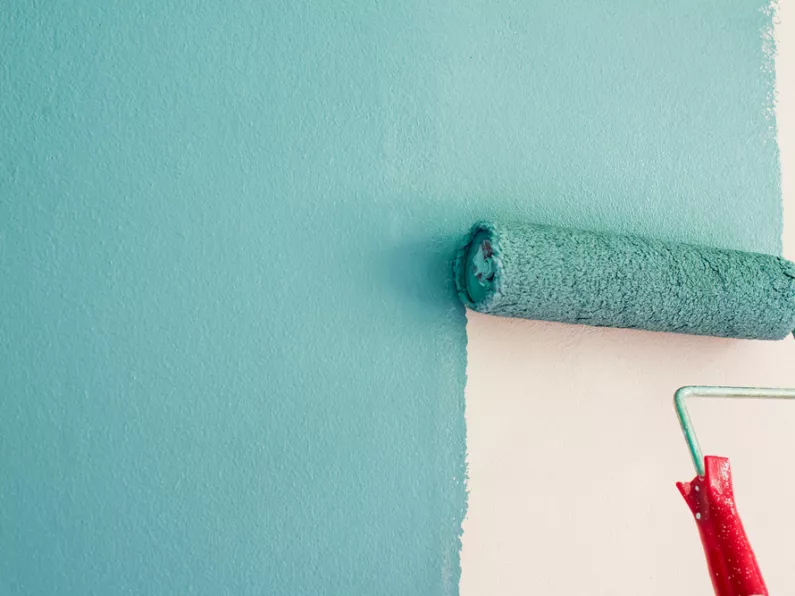A fresh lick of paint in a room can completely transform the space and breathe new life into your home.
It may be the case that your walls are scuffed and flaking and in desperate need of a refresh; or maybe you just fancy upgrading to this season's new trending colour.
And if you're thinking you can't afford to pay a painter to come in and do it, we're here to tell you that you don't have to!
Top tips for painting like a pro
Just follow our top tips for painting for beginners and you'll have your space transformed like a pro in no time.
- Pick your paint: It can be difficult choosing paints for your home, especially colours that you won't get fed up with very quickly. You can browse magazines and apps like Pinterest for inspiration, or you could visit a paint store and speak to an expert. Paint companies like Sherwin-Williams offer a variety of colour tools. For example, you could use their handy Colour Snap Visualiser tool where you can upload a photo of your space and see it transformed by any colour!
- Get tooled up: Every project is unique, and you may need different tools depending on the paint you choose and the condition of your walls, but a few must-haves are:
- Paint
- Paint roller
- Paint roller extension pole
- Drop cloths
- Paintbrushes
- Paint tray
- Sandpaper
- Painter’s tape
- Rags
- Putty knife
For both roller covers and brushes, it is worthwhile to pay extra for better tools.
Don't try to cut corners (excuse the pun!) by buying cheap rollers and brushes.
The quality of your work will suffer greatly as a result!
You can shop your must-have tools here.
- Cover up: This might seem obvious, but you'd be surprised how many people forget this simple first step. If you don't have enough space to move all of your furniture out of the room, cover it and the flooring with dust sheets and move the furniture into the middle of the room before you start your painting project. They'll save unwanted paint splatters. Oh, and make sure you open a window or door to ensure good ventilation. Take it a step further and use a low or zero VOC product for less order and exposure like the SuperPaint Interior Acrylic with Air Purifying Technology by Sherwin Williams.
- Prep your walls: Some people skip this step but trust us, it's worth the little bit of extra effort as you'll get a better finish and longer lasting paintwork. All it takes is filler for any holes and cracks, and a scraper to scrape off any flaky bits of paint. If you do have to fill holes with filler, make sure you sand the bumps down afterwards. And prime the filler! It's also important to wash your walls before you start painting. This is to remove any grease, dirt, crayon or mucky fingerprints! An effective way to do this is with a warm soapy water solution or shop-bought surface prep cleaners like these. Wear gloves and apply the solution to the walls. Once all walls have been cleaned, give the surface a final clean with warm water to remove any soap traces. Then leave the walls to dry thoroughly and get started!
- Tape it up: To avoid rogue streaks, cover light switches, sockets, skirting boards and window frames with masking tape. If you're painting one wall a different colour to the ceiling or adjacent walls, run masking tape along the edges so you get a nice, clean finish.
- Mix it up: Mix several cans of paint in a large bucket for a consistent colour throughout the room, as paint colour may vary slightly from one can to the next. If you have to open a new can in the middle of a wall, the difference may be noticeable. It’s best to estimate the amount of paint you’ll need and mix it in a large bucket. When coverage is difficult to estimate, add more rather than less when learning how to paint interior walls. You can always pour the leftovers back into cans.
- Get started: Once you open your paint, make sure to mix it well and then get stuck in. Tackle one wall at a time and start by taking a brush and “cutting in” the wall. That means using your paintbrush to paint along the corners of the wall from top to bottom and along the trims. Once you have that done, grab your roller to cover the main surface of the wall. Once the wall is dry to the touch, it’s ready for a second coat.
Top tips: If you're painting your ceiling as well, do that first. Then it's walls, woodwork and lastly floor if you're painting it. If you're planning one bold accent wall, paint the adjoining light-coloured walls first. And if your refresh means covering up dark walls with a brighter colour, you'll really need three coats: a primer and then two coats of the new colour to ensure full coverage.
- Avoid lap marks: Lap marks are the stripes caused by uneven layers of paint build-up. They occur when you roll over paint that’s already partly dry. So how do you avoid them? The key is to maintain a “wet edge”, so each stroke of your roller overlaps the previous stroke before the paint can begin to dry. Move backward where necessary to even out thick spots or runs. Don’t let the roller become nearly dry; it should always be at least half loaded. And keep the open side of the roller frame facing the area that’s already painted.
Top tips: To use a paint brush, hold it near the base of the handle. Dip half the bristles into the paint and tap on the lip of the can. Don't wipe it on the side. Paint with enough pressure to bend the bristles slightly, but don't bear hard on the brush. A 1"-2" brush offers good control, so it is well-suited for detail work such as cutting in around windows or painting molding. To apply paint to larger surfaces such as doors, use a 3"-4" brush.
When using a roller, roll it slowly into the paint in the tray. Then, roll it back and forth until the roller cover is evenly coated with paint. To remove excess paint, roll it onto the tray's ridges.
- Painting trims: Before painting your trims, you must use a damp sponge to clean off any dirt and grime. Then sand the surface and use the damp sponge again to wipe away any dust. Fill in holes, dents and cracks with a lightweight spackling compound and when it dries completely, lightly sand the spackled areas. Then dust off the walls and ceiling around the trim to ensure your painter's tape sticks well. Apply painter's tape to walls and ceilings surrounding the trim. Select 3 to 4 inches of painter's tape and firmly press it to the wall. While holding this "starting spot” in place, pull out 6 inches of tape, then firmly secure it to the wall. Repeat until the tape is secured for the length of the trim. After you have applied the tape, press the edges to ensure adhesion, as this helps prevent the paint from bleeding through the edges. Now you're ready to paint the trim but you must first apply a primer. Allow it to dry for 24 hours then after the drying period, if bare wood or spackle is showing, apply another coat of primer to the trim. After the primer dries, lightly sand the trim using 120-grit sandpaper to eliminate brush strokes or paint drips. Use a damp sponge to remove all sanding dust. Apply paint to the trim using short, horizontal brush strokes. Repeat the motion until a few feet of trim are covered in paint. Smooth over the series of short brush strokes with one long brush stroke. Do not add more paint to the brush but instead, drag the brush in one long motion over the freshly painted trim. Repeat if necessary, depending on the width of the trim, to create the appearance of long, smooth strokes. Start painting the next section of trim following steps three and four. Repeat until the trim is fully painted. Before the paint dries, carefully pull tape off the wall.
Top tip: If painting windows, don't bother taping around the window frame and grill. That takes too long, and paint usually ends up on the glass anyway. Instead, when paint splatters get on the glass, just let it dry and scrape it off.
- Wash your tools: When you're finished painting, clean your roller and rinse your brushes well with warm, soapy water. You need to use paint thinner to clean off oil-based paint. Then brush the bristles out straight with a brush comb and slip the brushes back into their original covers or wrap them in newspaper.
Sale time
If you needed a little push to get your home painting project started, then you're in for a treat!
Sherwin-Williams has a sale from November 4-8 with 40% off paints and stains, including Kool Seal Roof Coatings.
Prices start at TT$204.21, so what are you waiting for. Visit here for details.








